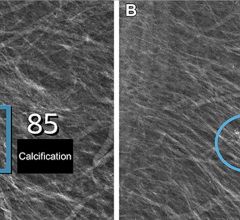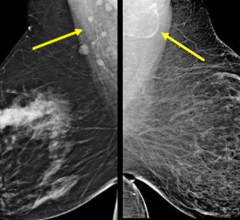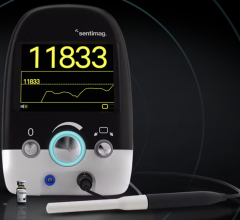December 17, 2010 – A new mammography technology that was displayed at RSNA 2010 is pending 510(k) approval by the U.S. Food and Drug Administration (FDA). The SenoBright Contrast Enhanced Spectral Mammography (CESM) technology is designed to let a physician image blood flow through angiography of the breast using a contrast agent and a dual energy acquisition technique.
Contrast agents can be used to highlight angiogenesis, the growth of small blood vessels potentially related to the presence of cancer. In addition to typical mammography images that show breast tissue density, CESM technology is designed to provide doctors with images of contrast uptake, which may indicate angiogenesis.
SenoBright uses X-rays at multiple energies to create two separate exposures. These resulting images specifically illuminate and highlight areas where there is contrast uptake and potentially angiogenesis.
"CESM presents images that look like mammography images with additional functional information. As the images are familiar, it can therefore be easily reviewed by surgeons and oncologists. Moreover in terms of workflow, a CESM exam takes from 5 to 10 minutes," said Clarisse Dromain, Gustave Roussy Cancer Institute, France.
As mammography mainly images tissue densities, SenoBright has been designed to produce an image that maps contrast uptake, adding the functional information to the conventional standard tissue density information of mammography. Doctors can highlight the proliferation of small blood vessels, potentially associated with cancerous tumor growth. Patients receive an intravenous injection of standard iodine contrast agent, and after two minutes undergo a five-minute digital mammography exam. CESM images are acquired in familiar mammography views so that that they can be correlated with standard results, facilitating interpretation by other specialists.
SenoBright is intended to allow for a procedure to be conducted by the same staff, using the same mammography equipment, potentially on the same day as the exam. This enables medical professionals to cut the critical time patients often have to wait from detection to diagnosis.
Digital mammography is considered a relevant means of breast cancer screening, delivering proven clinical outcomes. The sensitivity and specificity of images can, however, be affected by a range of factors. Dense breast tissue can overlap with lesions, which are not always visible on an X-ray, and radiologists’ interpretation of images can vary. Inconclusive digital mammography presents a range of challenges to healthcare professionals and patients. Ambiguity can result in diagnostic error.
CESM technology is intended to work as an upgrade to GE Healthcare’s Senographe DS and Senographe Essential digital mammography equipment.
SenoBright has not received the CE Mark and is not available for sale in the United States.
For more information: www.gehealthcare.com


 July 29, 2024
July 29, 2024 








